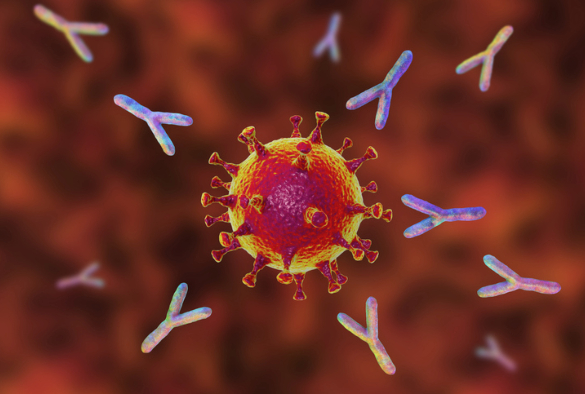People previously infected with SARS-CoV-2 show significantly higher T cell and antibody responses following a single dose of Pfizer/BioNTech vaccine compared with uninfected individuals, a collaborative study involving University of Liverpool researchers has found,
While both groups show robust immune responses after one dose, the higher response experienced by previously infected individuals likely represents a ‘boost’ to their immune defences, providing further protection against contracting COVID-19
Researchers from the Universities of Sheffield, Oxford, Liverpool, Newcastle, and Birmingham studied 237 healthcare workers, 113 of whom had previously been infected with COVID-19 for the PITCH study, funded by the Department of Health and Social Care and supported by the UK Coronavirus Immunology Consortium. This is the most in depth research in this area to date, and is published as a preprint with The Lancet.
Clinical trials report that the Pfizer/BioNTech COVID-19 vaccine is up to 95% effective against symptomatic disease after two doses. As well as examining effectiveness, it’s also important that we understand the underlying mechanisms of how the immune system responds to vaccination in different groups of people to allow us to optimise vaccination protocols and maximise protection against SARS-CoV-2 within our population. This study set out to examine immune responses after one dose of the Pfizer/BioNTech vaccine in individuals with and without a previous history of SARS-CoV-2 infection.
All study participants were vaccinated with the Pfizer/BioNTech BNT162b2 mRNA vaccine. For the 124 healthcare workers who had not previously had COVID-19 (termed ‘naïve’ individuals), 103 were given one dose of the vaccine and 21 were given two doses, with a gap of 23 days between doses. The researchers took blood samples from participants prior to and 28 days after vaccination to measure various aspects of the immune response, including antibodies and T cells. A range of analyses were used to examine aspects of the T cell response including the magnitude of response and the response to different proteins from SARS-CoV-2. Carrying out these T cell analyses is much more complex than antibody studies and difficult to undertake at scale – but this study is the largest and most in depth in the world to date in this field.
One dose of the Pfizer/BioNTech vaccine generated antibody and T cell responses in all but one of the 103 SARS-CoV-2 naïve participants. These responses were at a similar level or higher to those observed in individuals who had previously been infected with SARS-CoV-2 but were yet to be vaccinated. This backs up previous work showing a single dose of the Pfizer/BioNTech vaccine provides the majority of people with good protection from severe COVID-19.
After one dose of the vaccine, participants who had prior SARS-CoV-2 infection showed significantly higher antibody and T cell responses compared with SARS-CoV-2 naïve individuals, with antibody responses approximately 6.8 times higher and T cell responses approximately 5.9 times higher. We know from the SIREN study that antibody responses produced following natural infection are correlated with protection against reinfection. Although more research is needed, particularly regarding the role of T cells, the immune responses observed in both study groups after one vaccine dose are compatible with the substantial protection against contracting severe COVID-19 that has been reported by the SIREN study as well as further national population-based studies from Public Health Scotland, Public Health England and Israel. The previously infected group appear to receive an extra ‘boost’ to their immune defences from vaccination, which could further decrease their risk of infection if they were to come across the virus.
In previously infected individuals, the breadth of their T cell response expanded after vaccination to recognise more regions of the SARS-CoV-2 Spike protein. This is important as this broader response induced by vaccination could provide more robust protection against different viral variants should they be encountered. The study also found that the high antibody responses in previously infected individuals after vaccination may also retain activity against some SARS-CoV-2 variants of concern.
In the ‘naïve’ cohort who received two vaccine doses, their T cell responses were equivalent to those observed in participants who had previously had COVID-19 after one dose. However, antibody levels were still significantly lower than those observed in participants who previously had COVID-19 after one vaccine dose.
Overall, these findings provide an insight into the immune response generated by vaccination in both SARS-CoV-2 naïve and previously infected individuals. Following one dose of the Pfizer/BioNTech vaccine, both antibody and T cell responses are observed in the vast majority of individuals, although these were significantly higher in participants who had previously been infected with SARS-CoV-2. These findings increase our understanding of how immunity is generated by COVID vaccination and can feed into future vaccination strategies. They also provide reassurance that one dose of the Pfizer/BioNTech vaccine did elicit strong immune responses in this cohort. Further research is now needed to assess how the observed immune responses are maintained over the longer term and to increase our understanding of how they translate to real world effectiveness.
Dr Lance Turtle, Senior Clinical Lecturer in Infectious Diseases at the University of Liverpool, said: “This study is the first multicentre study to look at immune responses in real world rollout of Covid vaccines in the UK. in the study, we have shown that the response to a single dose of Covid vaccine looks very similar to the natural amenity that is left some months after natural SARS-CoV-2 infection. Although responses to one dose of vaccine are bigger in people who have previously been infected, we recommend people go for their second dose as planned in order to ensure greatest possible protection against new variants of the virus.”
The full paper is available here
